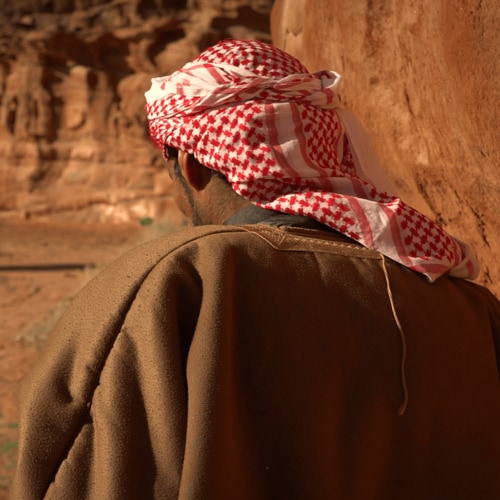We are often told that Jordan is one of the most water-poor countries on the planet and it is hard not to recognize the truth of this even as a relatively casual visitor. The first time I lived in Jordan, I wondered why I was so tired all of the time. Initially blaming Arabic immersion (which was certainly a factor), it eventually dawned on me that I was actually perpetually dehydrated. It wasn’t just a matter of drinking more water, though. Living with Jordan’s Bedouin completely changed my relationship to water. To this day, even living in verdant England, I still feel pangs of guilt every time I take a shower as I watch the torrent below circling the drain.
Such lingering embarrassment pales in comparison, though, to the time I fell asleep filling up one of the neighborhood water tanks. This time worn out from a long day helping some friends move some construction materials, I came home to find that the water authority had finally turned on our water supply. In the best of times, people in much of Jordan can expect piped water one day a week and in the summer this often stretches to every fortnight (or worse). When the water comes on, a clamor washes over settlements as residents rush to fill all of the water tanks that bedeck rooves throughout the kingdom. I clambered onto the roof, turned on the pump, and put the hose in the tank only to awake in horror hours later to see water pouring down my window. My neighbors, polite as always, tried to hide their disgust the next morning surveying the damage but it will probably always be one of those cringe-worthy experiences I cycle through in my darker moments.
Yet even more impressive is Borecký’s ability to find the beauty and poetry in more mundane features of Jordan’s environment: rust, mud, tire tracks and the little trickles of wasted water that inevitably overflow the country’s taxed and aging infrastructure.
Such mortifying episodes came flooding back to me as I watched Living Water, a collaboration between Jordan University’s Centre for Strategic Studies and Czech director Pavel Borecký. The film is a feast for the eyes and fans of experimental film in particular will appreciate the ethereal soundtrack and luxuriant long shots that capture Jordan’s stunning beauty. This goes for the psychedelic swirls of the iron-rich sandstone surrounding the Disi aquafer deep in the desert and the horrific flash-flooding that can also bedevil the country. Yet even more impressive is Borecký’s ability to find the beauty and poetry in more mundane features of Jordan’s environment: rust, mud, tire tracks and the little trickles of wasted water that inevitably overflow the country’s taxed and aging infrastructure.
Where Borecký shines through most as a gifted visual storyteller is in his depiction of the kingdom’s various megaprojects that materialize the odd mix of whimsy and monstrosity I associate with the best of the Jordanian oil economist-turned-novelist Abdelrahman Munif’s Cities of Salt. It is hard not to hear echoes of Munif’s prophetic vision throughout the film. Explaining the title of his classic series of novels about the discovery of oil in the Arabian peninsula, he warned, “When the waters come in, the first waves will dissolve the salt and reduce these great glass cities to dust. In antiquity, as you know, many cities simply disappeared. It is possible to foresee the downfall of cities that are inhuman. With no means of livelihood they won’t survive” (Ali 2004).
Borecký and his Jordanian collaborators seem to share this moral vision and it is indeed a powerful one. This is a story of human folly. Faced with hard ecological limits, we see a retreat into fantasy. A didactic voiceover whirls into action as a 3D model of Jordan and its subterranean geology rises from a dark abyss. We learn from the disembodied female voice speaking in an erudite register of Arabic that by tapping into the Disi aquafer Jordan is tapping an unrenewable resource of “fossil water,” making the film’s sweeping vistas of urban fountains and desert agricultural plantations all the more grotesque. A politics of accusation (Hughes et al. 2019) unfolds, with Disi’s Bedouin (described as “indigenous” in the promotional materials accompanying the film) vying with urban planners to argue their case for why they have the most legitimate right to the water, while others are greedy and irresponsible.
Yet so immersed is the film in the “micro” (little trickles of wasted water, petty patronage politics, and even pettier acts of theft) that it risks missing out on all of the wider geopolitical context.
Yet if this was the only exposure one had to debates about water in the region, one might well come away with a highly distorted picture of the situation. In a poem written by the Archaeologist Erga Rehns that frames the film, we learn that “something happened and the rivers disappeared.” The problem is that the passive voice here ends up doing a lot of work and we never really learn why this happened or who might be responsible. To be fair, there are occasional intimations of a larger picture. Yet so immersed is the film in the “micro” (little trickles of wasted water, petty patronage politics, and even pettier acts of theft) that it risks missing out on all of the wider geopolitical context. While those watching closely will recognize that Jordan is ultimately in a race with neighboring Saudi Arabia to grab as much of the Disi Aquafer as possible before the other can exhaust it, the film studiously avoids any discussion of Israel’s diversion of the eponymous “Jordan River” to meet its own population’s insatiable thirst for gardens, swimming pools and, yes, long hot showers.
There isn’t even an attempt to explain why so many people have ended up living in such a parched and agriculturally unviable area in the first place until the end of the film when we hear obliquely about how 600,000 Syrian refugees will only complicate the kingdom’s water problems. There is no mention, however, of the millions descended from Palestinian refugees who were pushed into the desert by hostilities to the much better-watered west. The film ends up buying into a classic nation-state-centric conceit of much development discourse that James Ferguson critiqued in his classic deconstruction of the development discourse around the South African bantustans in The Anti-Politics Machine (1994). It would be silly to offer an “ecological” explanation for why the Bronx is poor in relation to Manhattan, but draw an international border and push people over it and suddenly such explanations of marginalization are taken more or less at face value.
The key weakness of the film, then, is in how it ultimately wants to blame all of humanity indiscriminately. Returning at the end to Rehns’ diagnosis of the problem, we learn that “there are more people on the earth, more need for water, but there’s not enough” making Jordan a sort of microcosm of humanity’s foolish unwillingness to live within its means. She muses, “If human beings would care more about things outside of what they were told to care about, maybe the planet wouldn’t be in so much trouble.”
If everyone is responsible then, in a sense, who can really be blamed? Where could pressure be brought to bear?
Yet as an analysis this strikes this reviewer as embodying many of the shortcomings that Haraway (2015) and others have previously identified in concepts of the “Anthropocene” and “anthropogenic climate change.” If everyone is responsible then, in a sense, who can really be blamed? Where could pressure be brought to bear? The urge to anthropologize here ends up flattening much of the history of struggles that a more politically engaged film could have explored. Instead of seeing instances of poor water stewardship by some of the most frugal consumers of water on the planet as simply “human” we would see it more as the desperate struggle of a more transnational political order to maintain legitimacy amidst the forced displacement of millions of people struggling build new communities from the ashes. More attention to the wider post-colonial political context would reveal the persistence of coloniality that haunts the film’s subject matter. Looking at our largely blue planet, we might then instead turn away from neo-Malthusian nostrums about limited resources and see how the system of nation-states and its controls on free movement conspire to lock particular populations in intolerable ecological contradictions but that a politics of international solidarity could open up alternative horizons. Living Water should surely be commended for starting this conversation and exposing audiences to so many eloquent Jordanian voices, but it will not be the final word on these topics.
Read part 2 of this symposium here. You can also find out more about the film on its website.
References
Ali, T., 2004. “Exile and Kingdom.” The Nation <https://www.thenation.com/article/archive/exile-and-kingdom/>
Ferguson, J., 1994. The anti-politics machine:” development,” depoliticization, and bureaucratic power in Lesotho. U of Minnesota Press.
Haraway, D., 2015. “Anthropocene, capitalocene, plantationocene, chthulucene: Making kin.” Environmental humanities, 6(1), pp.159-165.
Hughes, G., Mehtta, M., Bresciani, C. and Strange, S., 2019. “Introduction: Ugly emotions and the politics of accusation.” The Cambridge Journal of Anthropology, 37(2), pp.1-20.
Photo: Still from Living Waters, by Pavel Borecký.



